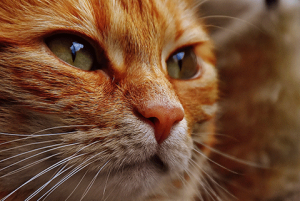FIP, or Feline Infectious Peritonitis, is a viral disease of cats that is almost universally fatal. However, it’s a really complicated condition, and (bizarrely) the “FIP Virus” probably isn’t transmissible from cat to cat in most cases. 
OK, so what causes it?
There’s a virus in cats called Feline Coronavirus (FCoV). This virus usually causes mild diarrhoea, as it replicates in the cells of the cat’s gut lining (as a result, it may also be called Feline Enteric Coronavirus, FECV). About 25% of pet cats have or are exposed to this virus, but that number goes up to over 80% in multi-cat households and may reach 100% in large colonies.
Now, most cats, once infected, are a bit poorly and have diarrhoea for a few days, but then recover. In the meantime, however, they have shed the virus (mainly in the faeces) to every other cat in the area. Some cats develop a strong, long-term immunity to it, but for most, their immunity fades over time, and they then become reinfected later.
How does that relate to FIP though?
The problem occurs when one of the virus particles in the cat’s body mutates in a specific way. This mutation (which occurs periodically but randomly as a result of the way the FCoV replicates itself) means that the virus can no longer replicate in the gut lining, but instead attacks the cat’s immune system and blood vessels. We call this the FIP Virus, but really it’s just a damaged and defective Feline Coronavirus. The good news is that, because it doesn’t replicate in the intestine, it is very unlikely to be spread to other cats; but the bad news is that it is a much, much more serious infection.
Some cats are able to mount a very strong “cell-mediated” immune response and kill the virus rapidly at this stage – these cats never develop the disease, despite being infected with the mutated FIP Virus.
Most cats, however, are unable to do this, and instead make antibodies – which doesn’t kill the virus, and in fact makes the symptoms worse. These cats will almost always die of the infection.
What cats are at risk?
Any cat infected with FCoV – this is predominantly younger cats (80% of FIP cases are less than two years old), and those in multi-cat homes or large colonies.
What are the symptoms?
The initial symptoms (that may persist for days or even weeks) are very vague and non-specific – typically lethargy, loss of appetite and a low fever. If the cat’s immune system cannot clear the virus at this stage, the condition will progress to one of the two main forms of the disease (although some cats may develop both simultaneously).
Wet FIP (also known as Effusive FIP)
- This is characterised by damage to blood vessels, so they leak fluid. This causes fluid build-up and inflammation in body cavities.
- Peritonitis – fluid in the abdomen, causing a pot-bellied appearance.
- Lumps or masses forming in the abdomen – these aren’t tumours but are essentially abscesses (pyogranulomas) in the gut, lymph nodes or other organs.
- Liver failure, causing jaundice.
- Pleural effusion – fluid in the chest, causing difficulty breathing. Many infected cats eventually suffocate or drown.
- These cats usually deteriorate rapidly, and die or have to be put to sleep in a matter of days or at most weeks.
Dry FIP (also known as Non-Effusive FIP)
- This occurs when the immune system is able to slow down the replication of the virus, but not stop it completely. It is characterised by chronic inflammation of blood vessels in the organs.
- Inflammation of the eyes (about 30% of cases) causing changes in shape and colour of the iris and fluid, bleeding into the eye, and often severe pain and sensitivity to light.
- Inflammation of the brain (encephalitis, and/or meningitis, also seen in about a third of cases), causing wobbliness, paralysis or seizures.
- Inflammation of any other organ, causing it to gradually fail.
- Cats with dry FIP will eventually die, but it is usually a much slower disease process, with cats surviving for potentially many months.
How do you diagnose it?
The only way to conclusively prove that the cat has FIP is by taking a biopsy (a surgical sample) of an infected tissue and sending it off to a lab to check if the mutated virus is present – blood tests cannot distinguish between normal FCoV and FIP virus. Unfortunately, many cats with the disease are too sick for surgery, so we would usually diagnose it based on the clinical signs, and the exact nature of the fluid (in wet FIP).
Can it be treated?
FIP remains a challenging and difficult disease to treat, however there have been significant recent developments in the management of this once fatal condition. Recent research has shown that some newer anti-viral drugs such as remdesivir, may be effective following trials in Australia. Remdesivir injection and GS-441424 tablets have recently become legally available in the UK, although they are a novel treatment, have not undergone extensive trials and are available only under special licence. The drug has been used to treat human viral infections including SARS-CoV-2 (COVID-19). Initial experience has been positive with response rates of 80-95% and therefore we have reason to be optimistic for the future, however the treatment remains very expensive and requires a long course of treatment. We look forward to learning more about the treatment of FIP over the next few years.
Please see icatcare.org for further information on FIP.
If you are concerned your cat may have FIP, make an appointment for them to be seen by one of our vets as soon as possible.
